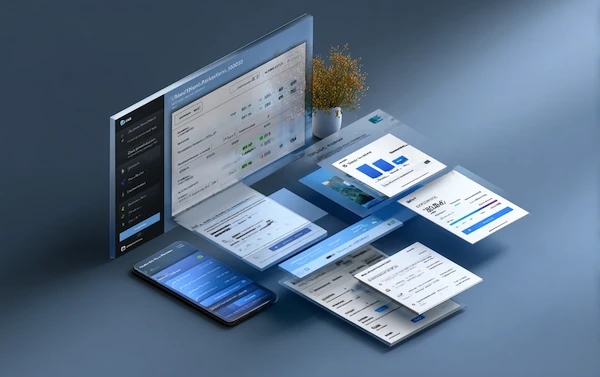Coming Up
What is Automated Expense Management?
Automated Expense Management refers to the use of software solutions to streamline the process of tracking, reporting, and auditing business expenses. Unlike traditional methods, which often involve manual data entry and paper receipts, automated systems leverage technology to simplify and speed up expense-related tasks.
Why is Automated Expense Management Important?
Automated expense management is crucial for several reasons:
- Efficiency: Reduces the time employees spend on expense reporting.
- Accuracy: Minimizes human errors in data entry and calculation.
- Compliance: Ensures adherence to company policies and regulatory requirements.
- Cost Savings: Identifies areas of overspending and potential cost-saving opportunities.
What are the Benefits of Automated Expense Management?
The benefits of automated expense management include:
- Time Savings: Automates repetitive tasks, freeing up employee time.
- Real-Time Reporting: Provides instant access to expense data for better decision-making.
- Improved Accuracy: Reduces errors associated with manual entry.
- Enhanced Compliance: Ensures that all expenses are within policy guidelines and regulatory requirements.
- Better Visibility: Offers comprehensive insights into spending patterns and trends.
What are the Challenges of Automated Expense Management?
While automated expense management offers numerous benefits, it also presents certain challenges:
- Implementation Costs: Initial setup and integration can be costly.
- User Adoption: Employees may resist transitioning from familiar manual processes to new automated systems.
- Data Security: Ensuring the security of sensitive financial information is paramount.
- System Integration: Integrating the expense management system with existing enterprise software can be complex.
How Does Automated Expense Management Work?
Automated expense management systems typically involve the following steps:
- Receipt Capture: Employees capture receipts using a mobile app or email forwarding.
- Data Extraction: The system extracts relevant data from the receipts using OCR (Optical Character Recognition) technology.
- Policy Enforcement: Automatically checks expenses against company policies and flags any discrepancies.
- Approval Workflow: Routes expenses through predefined approval workflows for managerial review.
- Reporting and Analysis: Generates detailed reports for analysis and audit purposes.
What are the Features of Automated Expense Management Tools?
Key features of automated expense management tools include:
- Mobile Accessibility: Allows users to submit expenses on-the-go via mobile apps.
- Integration: Seamless integration with ERP and accounting systems.
- Real-Time Notifications: Alerts users about the status of their expense reports.
- Advanced Analytics: Provides insights into spending patterns and identifies cost-saving opportunities.
- Customizable Workflows: Tailors approval processes to match organizational needs.
What are the Types of Automated Expense Management Solutions?
There are several types of automated expense management solutions available:
- Cloud-Based Solutions: Accessible from anywhere with internet access, ideal for remote teams.
- On-Premise Solutions: Installed on local servers, offering more control over data.
- Hybrid Solutions: Combine the benefits of both cloud and on-premise systems.
- Industry-Specific Solutions: Tailored to meet the unique needs of specific industries, such as healthcare or finance.
What are Use Cases for Automated Expense Management?
Automated expense management is used across various scenarios:
- Travel Expenses: Streamlining the process of capturing and reporting travel-related costs.
- Employee Reimbursements: Simplifying the submission and approval of employee expenses.
- Corporate Credit Card Management: Tracking and reconciling corporate card transactions.
- Project-Based Expenses: Managing expenses related to specific projects or clients.
- Compliance Reporting: Ensuring accurate and timely reporting for tax and regulatory purposes.
What to Look for in an Automated Expense Management Tool?
When selecting an automated expense management tool, consider the following factors:
- Ease of Use: User-friendly interface for quick adoption.
- Integration Capabilities: Compatibility with existing systems.
- Scalability: Ability to grow with your business.
- Security Features: Robust data protection measures.
- Customer Support: Reliable support and training resources.
How to Get Started with Automated Expense Management Tools?
To get started with automated expense management tools:
- Assess Needs: Identify the specific requirements of your business.
- Research Solutions: Compare different tools based on features, pricing, and user reviews.
- Request Demos: Arrange demonstrations to see the tools in action.
- Pilot Program: Implement a pilot program to test the tool in a real-world scenario.
- Full Implementation: Roll out the solution company-wide, ensuring adequate training and support.
How Solvexia Helps with Automated Expense Management?
Solvexia provides robust solutions for automated expense management, helping businesses streamline their expense processes through:
- Advanced Automation: Automates data preparation, processing, and reporting.
- Seamless Integration: Connects with existing ERP and accounting systems.
- Customizable Workflows: Tailors processes to meet specific business needs.
- Real-Time Analytics: Offers insights into spending patterns and potential savings.
Ready to enhance your expense management processes? Request a demo today!
.svg)































